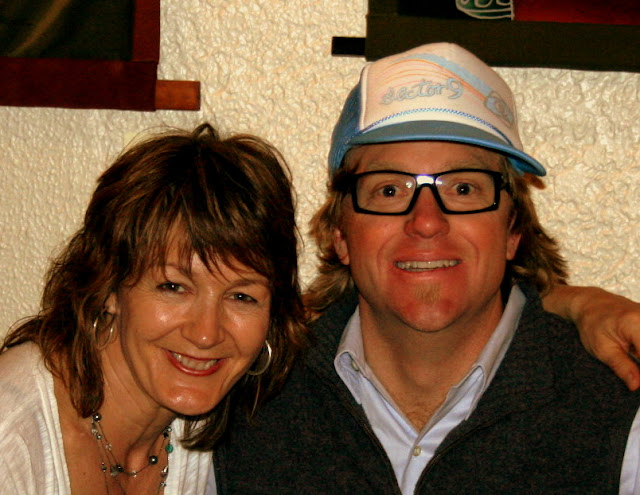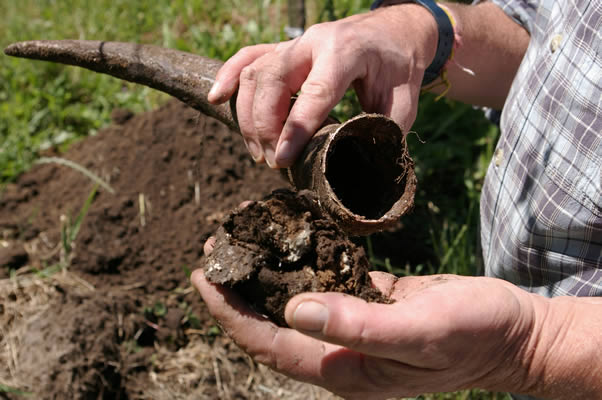The DC10: Mission Accomplished!
Beth Ribblett
 We finally did it! All ten members plus two dogs were in attendance for our 3rd meeting of the DC, and I have to say, I think it was the best yet! While "Classic Rock" presented quite a challenging theme, all members rose to the occasion and beyond to create pairings and courses that raised the bar on what has now become our monthly food and beverage "event".
We finally did it! All ten members plus two dogs were in attendance for our 3rd meeting of the DC, and I have to say, I think it was the best yet! While "Classic Rock" presented quite a challenging theme, all members rose to the occasion and beyond to create pairings and courses that raised the bar on what has now become our monthly food and beverage "event".Kerry and I had the opening cocktail and amuse bouche. Going with a "Deep Purple" theme we created a Creme de Violette, Cita
 del Gin and fresh lemon juice cocktail served straight up in a chilled martini glass. The touch of sweet, violet candy-like-taste of the liquor combined with the very herbal but not too junipery gin and the tangy squeeze of lemon came out the perfect shade of neon purple and was a delicious accompaniment to our "Smoke on the Water" amuse. The smoked shrimp served on waves of sauteed purple cabbage laid out in a Gulf Coast sea shell, rocked with the appropriate Deep Purple sound track playing in the background.
del Gin and fresh lemon juice cocktail served straight up in a chilled martini glass. The touch of sweet, violet candy-like-taste of the liquor combined with the very herbal but not too junipery gin and the tangy squeeze of lemon came out the perfect shade of neon purple and was a delicious accompaniment to our "Smoke on the Water" amuse. The smoked shrimp served on waves of sauteed purple cabbage laid out in a Gulf Coast sea shell, rocked with the appropriate Deep Purple sound track playing in the background.As one course ends, the next couple begins their final secret preparations in
 the kitchen while the rest of us hang out on the back porch watching the evenings entertainment. Sangi was invited to dinner club by his host Mighty Dog, and their backyard antics were a blur of activity that kept us laughing for four hours. The only breaks taken were to run into the pond for a drink of water or to pull our a plant or two for their never ending game of chase.
the kitchen while the rest of us hang out on the back porch watching the evenings entertainment. Sangi was invited to dinner club by his host Mighty Dog, and their backyard antics were a blur of activity that kept us laughing for four hours. The only breaks taken were to run into the pond for a drink of water or to pull our a plant or two for their never ending game of chase."Lavern" and her partner, who we'll call Shirley to keep his identity hidden, was finally able t
 o attend a dinner club meeting. Feeling the need to prove his worthiness to the group, he and his partner took it to another level by creating place mats that combined an old Cream poster photoshopped with a Country Joe and the Fish graphic. They also created what was probably my favorite dish of the evening. Even though beer is not my thing (sorry Lavern!), their pairing of seven seed-crusted salmon over garlic lentils topped with creme fraiche and micro arugula served with Skullsplitter Scotch Ale, all to the tune of "Strange Brew", was a total knockout!
o attend a dinner club meeting. Feeling the need to prove his worthiness to the group, he and his partner took it to another level by creating place mats that combined an old Cream poster photoshopped with a Country Joe and the Fish graphic. They also created what was probably my favorite dish of the evening. Even though beer is not my thing (sorry Lavern!), their pairing of seven seed-crusted salmon over garlic lentils topped with creme fraiche and micro arugula served with Skullsplitter Scotch Ale, all to the tune of "Strange Brew", was a total knockout!The next course by couple 3 took a lot of time to get to the table
 but we all understood once we saw their presentation! Their "Cherry Bomb" appetizer was truffled mushroom risotto-stuffed tomatoes topped with manchego and infused with lemon-herb smoke via electronic bong served under glass to Joan Jett's version of the song. It was quite an ambitious undertaking that was greeted with lots of ohhhs and ahhhs by the group even as we argued over whether Joan Jett was really considered classic rock! Their pairing with the Hope and Grace Santa Lucia Pinot was delightful and their dish got high marks for creativity and presentation!
but we all understood once we saw their presentation! Their "Cherry Bomb" appetizer was truffled mushroom risotto-stuffed tomatoes topped with manchego and infused with lemon-herb smoke via electronic bong served under glass to Joan Jett's version of the song. It was quite an ambitious undertaking that was greeted with lots of ohhhs and ahhhs by the group even as we argued over whether Joan Jett was really considered classic rock! Their pairing with the Hope and Grace Santa Lucia Pinot was delightful and their dish got high marks for creativity and presentation!
Our hosts went way over board with their "Paint it Black" entree of blackened drum served on grilled leaves of romaine served aside Grilled shrimp Viet- served over rice noodles tossed with cilantro, napa cabbage & cucumber with fish sauce, lime juice and sriracha dressing. Lots of spicy heat came with the fish so their choice of the Donhoff Riesling provided the perfect mouth cooling accompaniment!
The Rolling Stones songs kept coming as the dessert course was s
 erved to "Brown Sugar" and probably my favorite wine of the night, the Maculan Torcolato by couple #5. The creator of the dessert went through a few trials and tribulations with an Abita Purple Haze ice cream before she ended up with this delicious brown sugar custard with fresh whipped cream and candied orange confetti that perfectly tied the dish to the marmalade qualities of the late harvest wine. An exquisite end to our indulgent food and beverage orgy!
erved to "Brown Sugar" and probably my favorite wine of the night, the Maculan Torcolato by couple #5. The creator of the dessert went through a few trials and tribulations with an Abita Purple Haze ice cream before she ended up with this delicious brown sugar custard with fresh whipped cream and candied orange confetti that perfectly tied the dish to the marmalade qualities of the late harvest wine. An exquisite end to our indulgent food and beverage orgy!And even though April's theme of "bread" as the secret ingredient drew many groans from the crowd, all members are anxiously awaiting our next meeting!












































